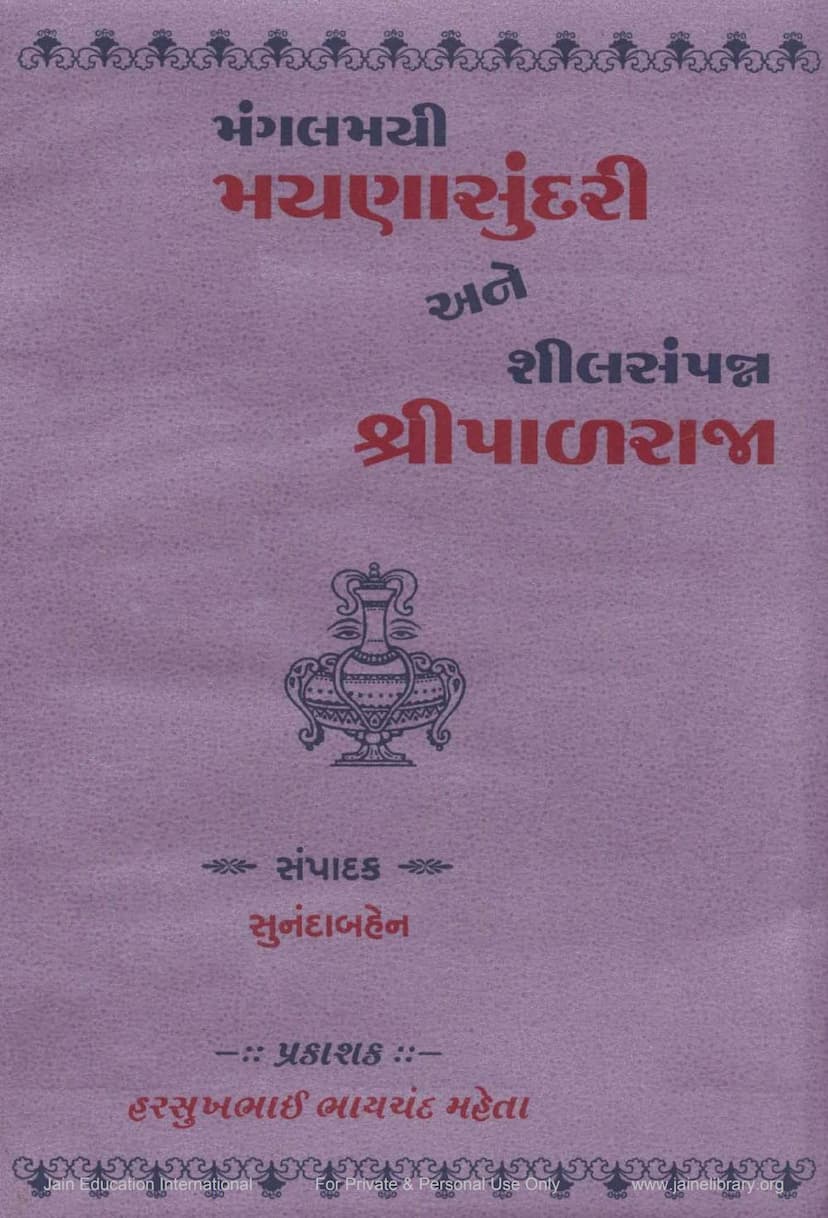Maynasundari Ane Shripal Raja
Added to library: September 2, 2025

Summary
Here's a comprehensive summary of the Jain text "Maynasundari ane Shripal Raja," based on the provided pages:
Title: Maynasundari ane Shripal Raja (Maynasundari and King Shripal)
Author: Sunandaben Vohra
Publisher: Sunandaben Vohra
Overview:
This book is a compilation and retelling of the famous Jain story of King Shripal and Queen Maynasundari, emphasizing their adherence to Jain principles, particularly the worship of Navpad (the nine supreme beings) and the concept of karma. The book is presented as a tribute to the spiritual life of the compiler's (Sunandaben Vohra's) elder, Harima Mehta.
Key Themes and Content:
-
Homage and Dedication: The initial pages dedicate the book in remembrance of "Pujya Varil Harima Mehta," highlighting her 24th death anniversary and her deeply spiritual life. Harima Mehta is described as a virtuous soul who integrated dharma into her daily life, even after facing widowhood at a young age. She established a Jain Pathshala and was devoted to ascetic practices and pilgrimages.
-
The Significance of Navpadji: A central theme is the immense importance of worshipping Navpadji in Jainism. Navpadji refers to the five supreme beings (Arihant, Siddha, Acharya, Upadhyaya, Sadhu) and the four aspects of Dharma (Right Faith/Darshan, Right Knowledge/Gyan, Right Conduct/Charitra, Right Austerity/Tap). The text emphasizes that Shripal and Maynasundari attained eternal happiness through the worship of Navpadji.
-
The Story of Shripal and Maynasundari: The book narrates the life story of Shripal and Maynasundari as told by Lord Gautam Swami to King Shrenik.
- Maynasundari's Wisdom: The story begins with Maynasundari, Princess of Ujjaini, who, due to her Jain upbringing, possesses profound wisdom about karma. She asserts that individuals are responsible for their own happiness and suffering, a concept that initially angers her father, King Prajapal.
- Shripal's Transformation: Shripal, the prince of Champapuri, is orphaned and faces usurpation of his kingdom. He endures immense hardship, even contracting leprosy due to past karma. He is eventually married to Maynasundari, who accepts him despite his condition, demonstrating her steadfast faith and adherence to dharma.
- The Power of Navpadji Worship: Shripal's leprosy is cured through Maynasundari's guidance and their rigorous worship of Navpadji. This event highlights the transformative power of sincere devotion and adherence to Jain practices.
- Shripal's Adventures and Royal Marriages: The narrative follows Shripal's extensive travels and his encounters. Through his courage, adherence to dharma, and the grace of divine artifacts (like a magical necklace), he gains immense wealth, reputation, and marries eight beautiful princesses: Madansena, Madanmanjusha, Manmanjari, Gun sundari, Shailoksundari, Shrungarsundari, Jaysundari, and Tilaksundari. Each marriage often occurs through trials, tests of skill (like music or archery), or acts of valor, showcasing Shripal's inherent qualities and the blessings of his past good karma and devotion.
- Karma and Its Manifestation: The story repeatedly illustrates the principles of karma. Shripal's initial suffering (leprosy, homelessness) is a result of past negative karma, while his subsequent success, wealth, and virtuous relationships are due to his good karma and the spiritual practices he undertakes. The story contrasts the fate of the greedy merchant Dhaval, who is ultimately destroyed by his deceitful actions, with Shripal's virtuous path leading to prosperity and spiritual growth.
- The Role of Guidance and Support: The text emphasizes the importance of spiritual guidance. Munis (ascetics) and scriptures provide the framework for Shripal and Maynasundari's spiritual journey. Maynasundari's unwavering faith and adherence to dharma are instrumental in Shripal's recovery and upliftment.
- The Narrator's Purpose: The book aims to convey the philosophical depth of Jainism, particularly the importance of karma, detachment, and the ultimate goal of liberation through practices like Navpadji worship. It encourages readers to cultivate good thoughts and conduct, strengthen their faith, and understand the cycle of karma.
-
The Narrative Style: The book is presented in a devotional and instructive style, common in Jain religious literature. It recounts events with vivid descriptions and moral lessons. The compiler, Sunandaben Vohra, has condensed the narrative for contemporary readers while retaining its core message.
-
Specific Instructions for Navpadji Worship: The latter part of the book provides detailed guidelines on how to perform the Navpadji worship, including the proper observances, fasting (Ayambill), prayer mantras, the significance of colors associated with each Padas (Pad), and the ultimate goal of achieving liberation. It highlights that the worship is not merely ritualistic but requires inner purity, detachment, and focused devotion.
-
The Story of Sur Sundari: The text also briefly touches upon the tragic fate of Sur Sundari, Maynasundari's sister, who, due to her arrogance and lack of faith, experiences immense suffering and hardship, eventually becoming a dancer. This serves as a stark contrast to Maynasundari's path of righteousness.
-
The Teachings of Lord Mahavir: The narrative culminates with Lord Mahavir's discourse on the significance of Navpadji, reinforcing the story's spiritual message and the path to salvation.
In essence, "Maynasundari ane Shripal Raja" is a Jain narrative that beautifully intertwines a compelling story of trials, triumphs, and spiritual growth with profound teachings on karma, dharma, and the transformative power of devotion to Navpadji, serving as a guide for spiritual seekers.